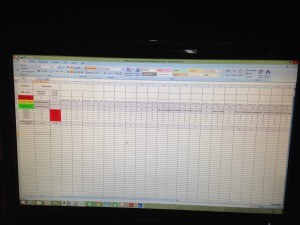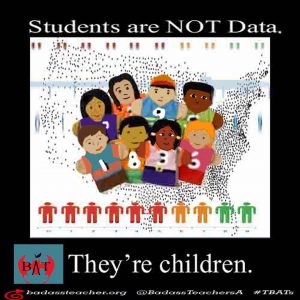(Continuing my recent set of “positive” posts.)
Sometimes I worry about my ability to write happy posts. I look at the above title and I think it’s a version of “We will find a vaccination before the Zombie Apocalypse completely destroys the human race.” Unqualified sources of happiness seem hard to identify in the greater sphere of American education.
But I am going to praise data, even as I think of the caveats that ought to be added, given the opportunity costs created by our current obsession with data. When spreadsheets preempt lesson planning, tutoring and parent contact, we are going awry in our attempts to improve education. When data is used without an understanding of the lives and characteristics of the students generating that data, we are going badly awry. GIGO — or Garbage In, Garbage Out — should be a focus at all times as governments and administrators demand more numbers. Poorly-understood data has too often been used as a weapon against teachers, especially in under-performing school districts.
That said, using data to plan and execute instruction has benefits when intelligently implemented. Let’s face it: Some kids are masters of the “nod.” Yes, Ms. Q, I understand, their body language says. Nod. Nod. They may be talented crammers, able to pull together the test or quiz that supports that body language. One challenge posed by academic nosedives comes from the ability of some students to fake their way through confusion for at least a year or two before the extent of that nosedive becomes clear. Yes, alert teachers will catch the dive eventually, but if too many months have gone by, catching up may prove difficult or even impossible.
Teachers hate the word impossible, but impossible is possible. No matter how hard I am willing to work, if Lonnie will not work with me, Lonnie may be unable to fill in the gaps in his knowledge. If I have 40 students in my classroom, I may not realize how far behind Lonnie has fallen for some time, and Lonnie may not bother to inform me, especially if he would lose his lunch or afternoon gaming time by asking for help.
Catching the fall sooner is always better. Data helps catch those falls. What do the MAP scores say? What trends can be identified in the spreadsheet? Sometimes the right question at the right time — Why do you think that test caused you trouble? — can start the interventions before a true crisis begins. Data can flag the quiet kids especially, those kids who hardly ever call attention to themselves.
Eduhonesty: Data makes me think of that proverbial two-edged sword. Spewing out more data does not always serve the greater good. But when implemented properly, data-driven instruction can clear away wisps of wishful thinking and unmask our nodders. We can start interventions sooner to pull kids back onto the track. We can make special education placements sooner, too.
I’ll offer the push toward data-driven instruction as another example of one more recent educational fashion that — when implemented by people who know what they are doing — often benefits America’s children.
Nevertheless, I add the last caveat:

